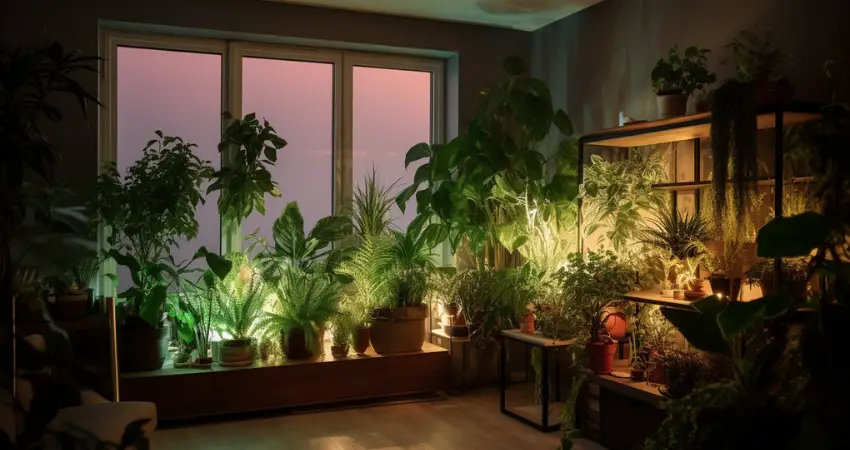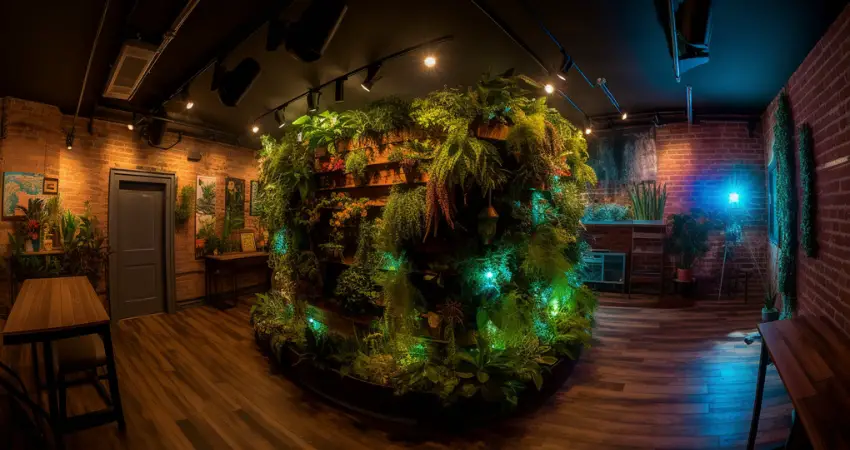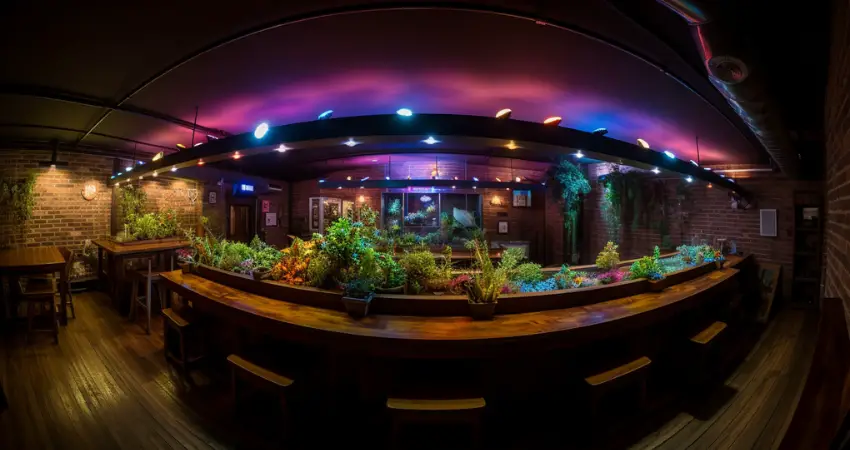Are you looking to level up your indoor gardening game? If so, it’s time to shed some light on the incredible benefits of full spectrum lighting for indoor plants. In this comprehensive guide, we’ll explore the science behind full spectrum lighting, delve into its advantages for indoor plant growth, and provide valuable insights on how to choose the best full spectrum lighting solution for your indoor garden.
From enhanced photosynthesis and healthier plant growth to increased flowering and fruiting, full spectrum lighting is revolutionizing the way we cultivate plants indoors. So, let’s illuminate the path to indoor gardening success and uncover the transformative power of full spectrum lighting!
Light Spectrum and Photosynthesis

The visible light spectrum includes the range of wavelengths our eyes can perceive, which includes colors from violet to red. Each color corresponds to a specific wavelength: violet (380-450 nm), blue (450-495 nm), green (495-570 nm), yellow (570-590 nm), orange (590-620 nm), and red (620-750 nm).
Photosynthesis is the process by which plants convert light energy into chemical energy. This energy is then used to synthesize glucose and other organic molecules from carbon dioxide and water. The main players in this process are the chlorophyll pigments found in the chloroplasts of plant cells.
Chlorophyll pigments absorb light energy and transfer it to specialized protein complexes called photosystems. These photosystems use the absorbed light energy to drive the production of ATP (adenosine triphosphate) and NADPH (nicotinamide adenine dinucleotide phosphate), which are used to power the synthesis of glucose.
While plants can absorb a broad range of light wavelengths, certain colors are more effective at driving photosynthesis. The action spectrum for photosynthesis is heavily weighted towards blue and red light, with green light being less effective as it is mostly reflected by the plant’s pigments.
Comparing Full Spectrum Lighting to Natural Sunlight

Natural sunlight contains a well-balanced mixture of all colors in the visible light spectrum, as well as ultraviolet (UV) and infrared (IR) radiation. This full spectrum of light is essential for optimal plant growth, as it provides the necessary energy for photosynthesis and other processes.
Full spectrum lighting aims to mimic the composition of natural sunlight, providing a balanced blend of colors in the visible light spectrum. While some full spectrum lights also include UV and IR radiation, not all do. Nevertheless, they still offer significant benefits for indoor plants compared to more limited-spectrum artificial lighting options.
There are several artificial lighting technologies commonly used for indoor plant growth:
- Fluorescent lights: These include compact fluorescent lights (CFLs) and linear fluorescent tubes. They can provide a broad spectrum of light, but often lack the intensity needed for optimal plant growth.
- High-Intensity Discharge (HID) lamps: Examples include metal halide (MH) and high-pressure sodium (HPS) lamps. HID lamps produce a more intense light but can be less energy-efficient and emit a lot of heat.
- Light Emitting Diodes (LEDs): LEDs are versatile and energy-efficient, with the ability to produce a customized spectrum of light. Full spectrum LED lights are now widely available and offer a range of benefits for indoor plants.
Benefits of Full Spectrum Lighting for Indoor Plants

Improved Photosynthesis
Full spectrum lighting enhances photosynthesis by providing a balanced blend of wavelengths that plants can efficiently absorb. This leads to:
- Light absorption efficiency: With the right balance of blue, red, and other colors, full spectrum lighting ensures maximum absorption of light energy by chlorophyll pigments.
- Enhanced growth rates: Improved photosynthesis results in faster and more vigorous growth, enabling indoor plants to thrive.
Healthier Plant Growth
Full spectrum lighting promotes healthier plant growth in several ways:
- Stronger root development: A balanced light spectrum encourages robust root growth, providing plants with better access to water and nutrients.
- Greater resistance to pests and diseases: Healthier plants are more resilient, reducing the likelihood of pest infestations and disease outbreaks.
Better Flowering and Fruiting
Full spectrum lighting also has a significant impact on flowering and fruiting in plants:
- Increased yield: Plants grown under full spectrum lighting tend to produce more flowers and fruits, leading to higher yields.
- Enhanced flavor and nutrient content: Full spectrum lighting can also improve the taste and nutritional value of fruits and vegetables by supporting optimal plant metabolism.
Mimicking Natural Light Cycles
Full spectrum lighting can help recreate natural light cycles, which are essential for plant health:
- Photoperiodism: Many plants require specific daylengths to trigger flowering and other developmental processes. Full spectrum lighting can be adjusted to simulate these natural photoperiods.
- Circadian rhythms: Plants, like humans, have internal clocks that regulate growth, metabolism, and other functions. Full spectrum lighting helps maintain these circadian rhythms, promoting overall plant health.
Full Spectrum Lighting Applications

Full spectrum lighting can be used in various settings to support indoor plant growth:
Indoor Gardening
- Greenhouses: Full spectrum lighting can supplement or replace natural sunlight in greenhouses, ensuring optimal growth conditions year-round.
- Vertical farms: These innovative farming systems rely on artificial lighting, and full spectrum LEDs are an ideal choice for energy-efficient, high-quality light.
- Hydroponics and aeroponics: Soil-less growing systems, such as hydroponics and aeroponics, often depend on artificial lighting, making full spectrum lighting a valuable addition.
Home and Office Settings
- Houseplants: Full spectrum lighting can help houseplants thrive, particularly in rooms with limited natural light.
- Horticultural therapy: The use of plants and gardening to improve mental and physical well-being can be enhanced by full spectrum lighting, promoting healthier plant growth and a more therapeutic environment.
Research and Education
- Plant biology: Full spectrum lighting is a valuable tool for researchers studying plant physiology, genetics, and other aspects of plant biology.
- Agricultural science: Advances in full spectrum lighting technology have the potential to revolutionize agriculture by improving crop yields, reducing energy consumption, and enabling year-round production.
Factors to Consider when Choosing Full Spectrum Lighting

When selecting full spectrum lighting for your indoor plants, consider the following factors:
Light Intensity
- Lumens: Lumens measure the total amount of visible light emitted by a light source. Higher lumen output indicates a more intense light, which is crucial for photosynthesis and plant growth.
- Photosynthetically Active Radiation (PAR): PAR refers to the wavelengths of light that are most effective for photosynthesis. When comparing full spectrum lights, look for those with high PAR values.
Color Temperature
- Kelvin scale: Color temperature is measured in Kelvins (K) and describes the overall appearance of a light source. Cool light (higher Kelvin values) is rich in blue wavelengths, while warm light (lower Kelvin values) is rich in red wavelengths. Choose a full spectrum light with a color temperature that suits your plants’ needs.
- Cool and warm light: Some plants may require more blue light during vegetative growth and more red light during flowering. Select a full spectrum light that offers a balance of cool and warm light, or consider adjustable options.
Energy Efficiency
- LED vs. traditional lighting technologies: Full spectrum LED lights are typically more energy-efficient than traditional lighting options, such as fluorescent lights and HID lamps. They also have a longer lifespan and produce less heat, making them a more cost-effective choice in the long run.
- Operating costs: When choosing full spectrum lighting, consider the initial investment, energy consumption, and maintenance costs. LEDs may have a higher upfront cost, but their long-term savings can offset this initial expense.
Setting Up Full Spectrum Lighting
- Placement: Proper positioning of full spectrum lights is crucial for even light distribution and optimal plant growth. Ensure that the lights are placed at the appropriate distance from the plants, which may vary depending on the light’s intensity and the specific plant species.
- Adjustable height: As plants grow, you may need to adjust the height of the lights to maintain the appropriate distance. Look for lighting systems with adjustable heights or suspension systems to accommodate plant growth.
- Light duration: Determine the appropriate photoperiod for your plants, and set up a timer to automate the on and off cycles for your full spectrum lights.
Potential Drawbacks of Full Spectrum Lighting
- Initial cost: Full spectrum lighting, particularly LED systems, can be more expensive upfront compared to traditional lighting options. However, the long-term benefits and savings usually outweigh the initial investment.
- Compatibility with existing setups: If you are transitioning from traditional lighting systems to full spectrum lighting, you may need to make adjustments to your existing setup, such as modifying the suspension system or electrical connections.
Conclusion
In summary, full spectrum lighting offers numerous benefits for indoor plants, including improved photosynthesis, healthier growth, better flowering and fruiting, and the ability to mimic natural light cycles. Its applications extend from indoor gardening and home settings to research and education in plant biology and agricultural science.
By considering factors such as light intensity, color temperature, and energy efficiency, you can select the ideal full spectrum lighting solution for your indoor plants. As technology continues to advance, we can expect even more innovative and efficient full spectrum lighting options to become available, further revolutionizing indoor plant cultivation.
